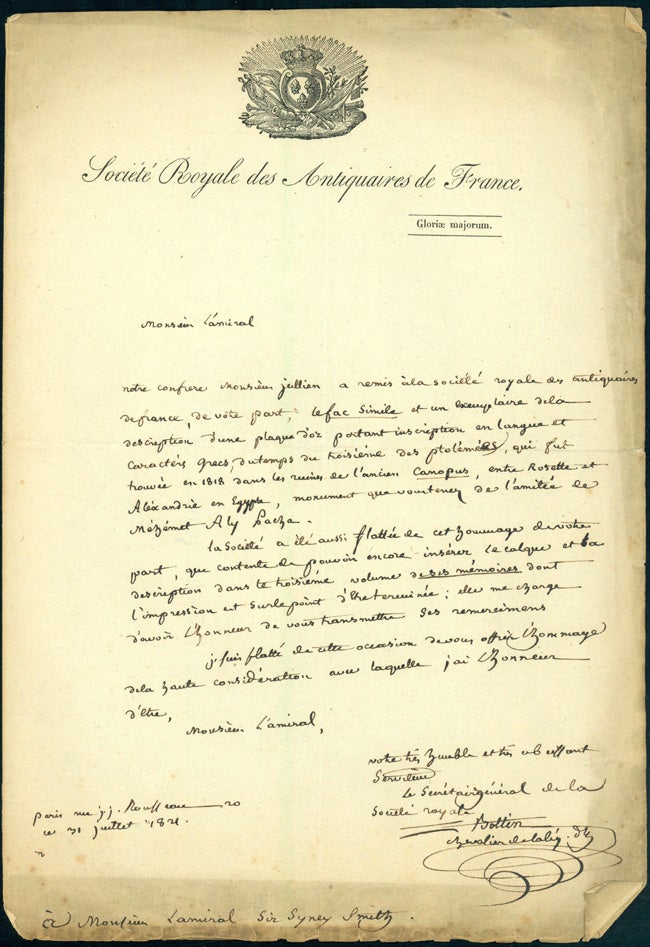
Autograph letter signed to Sir Sidney Smith, with enclosed ms. description of an old Egyptian plaque in another hand
Publisher Information: Paris: 1821.
Bottin, Sébastien (1764-1853). (1) Autograph letter signed to Admiral Sir [William] Sidney Smith (1764-1840). Paris, July 31, 1821. 1 page plus integral blank, on stationery of the Société Royale des Antiquaires de France. 317 x 219 mm. (2) Description d'une plaque d'or portant une inscription en lange et caractères grecs, du tems du troisième des Ptolemés . . . Manuscript in an unidentified hand, possibly that of Smith. N.p., n.d. [1821]. 2-1/2pp. 309 x 202 mm. Minor marginal fraying and spotting, a few small tears along folds.
From the secretary of the Société Royale des Antiquaires de France to British Admiral Sir Sidney Smith, thanking Smith for the gift of a facsimile of an ancient Egyptian artifact. The original artifact, dating from the reign of Ptolemy III in the third century B.C.E., was a golden plaque measuring 6 x 2.5 inches, with an inscription in Greek commemorating Ptolemy III's dedication of a temple to Osiris. This plaque, discovered by Egyptian workers in the ruins of Canopus in 1818, came into the possession of Egypt's ruler, Mehmet Ali Pasha. Mehmet Ali sent the artifact to Admiral Sir Sidney Smith, who had played a major role in the defeat of invading French forces in Egypt during the Napoleonic Wars. Smith settled in France after Napoleon's final defeat at Waterloo and remained there for the rest of his life; it is thus not surprising that he presented his gift to a French institution rather than an English one. Bottin's letter reads in part:
"Notre confrère Monsieur Jullien a remis à la Société royale des antiquaires de France, de votre part, le facsimile et un exemplaire de la description d'une plaque d'or portant inscription en lange et caractères grecs, du temps du troisième des Ptolémées, qui fut trouvée en 1818 dans les ruines de l'ancien Canopus, entre Rosette et Aléxandrie en Egypte, monument que vous tenez de l'amitié de Méhémet Aly Pasha.
La Société a été aussi flattée de cet hommage de votre part, que contente de pouvoir encore insérer le calque et la description dans le troisième volume de ses mémoires dont l'impression est sur le point d'être terminée ; elle me charge d'avoir l'honneur de vous transmettre des remercîments."
[Our colleague Mr. Jullien has, on your behalf, sent to the Société royale des antiquaires de France a facsimile and copy of the description of a golden plaque bearing an inscription in Greek and in Greek characters, from the time of Ptolemy III, which was found in 1818 in the ruins of ancient Canopus, between Rosetta and Alexandria, which you have through the friendship of Mehmet Ali Pasha.
The Society was so pleased by your gift that it will insert the tracing and description in the third volume of its memoirs, which has nearly finished printing; they have given me the honor of transmitting their thanks.]
The enclosed manuscript description of the plaque and facsimile, possibly written by Smith, goes into further detail about the plaque and the circumstances of its discovery. It gives the dimensions of the original plaque ("6 pouces de longeur par 2 de largeur") and translates the inscription as "Le Roi Ptolomé [fils] de Ptolomé et Arsinoé frères déifiés, et la Reine Berenice sœur et femme [du dit] [consacrent ou dédient] ce Temple, à Osiris" [King Ptolemy (son) of deified brothers (?siblings?) Ptolemy and Arsinoë, and Queen Berenice sister and wife (of same) (consecrate and dedicate) this temple to Osiris]. Also noted is the fact that the plaque was discovered "sur une pierre fondemantale, entre deux tuiles de matière vitrifiée" [on a foundation stone, between two glazed tiles], and that the glazes on the tiles, one blue and one green, had been analyzed by chemists to discover the nature of their coloring agents.
Book Id: 40473Price: $1,250.00
